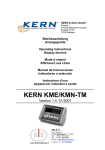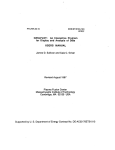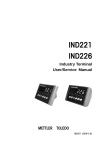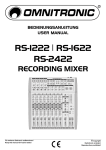Download USER MANUAL
Transcript
K R A ME R E LE CT R O N IC S L TD . USER MANUAL MODEL: SP-1G 3G HD-SDI Synchronizer P/N: 2900-000766 Rev 4 Contents 1 Introduction 1 2 2.1 2.2 2.3 3 3.1 Getting Started Achieving the Best Performance Safety Instructions Recycling Kramer Products Overview Defining the SP-1G 3G HD-SDI Synchronizer 2 2 3 3 4 5 4 4.1 Connecting the SP-1G 3G HD-SDI Synchronizer Connecting the SP-1G via RS-232 7 8 5 5.1 5.2 Operating the SP-1G Using the LCD Display Using the Front Panel Buttons 9 9 10 6 6.1 6.2 6.3 6.4 6.5 6.6 6.7 6.8 6.9 6.10 6.11 6.12 Using the SP-1G Menus Loading Setups Saving Setups Using the Factory Reset Setting the Video Signal Setting the Image Size and Position Setting the Genlock Setting the No-Signal Screen Setting the Machine Address Displaying Status Setting LCD Brightness Setting the Sleep Mode Enabling and Activating the Genlock Input Video Function 11 14 14 14 15 16 18 20 20 21 21 21 22 7 Technical Specifications 23 8 Kramer Protocol 2000 24 Figures Figure 1: SP-1G 3G HD-SDI Synchronizer Figure 2: Connecting the SP-1G 3G HD-SDI Synchronizer Figure 3: Connecting the SP-1G as a Clean Switch Figure 4: SP-1G Menu Map 5 7 8 13 SP-1G – Contents i 1 Introduction Welcome to Kramer Electronics! Since 1981, Kramer Electronics has been providing a world of unique, creative, and affordable solutions to the vast range of problems that confront the video, audio, presentation, and broadcasting professional on a daily basis. In recent years, we have redesigned and upgraded most of our line, making the best even better! Our 1,000-plus different models now appear in 11 groups that are clearly defined by function: GROUP 1: Distribution Amplifiers; GROUP 2: Switchers and Routers; GROUP 3: Control Systems; GROUP 4: Format/Standards Converters; GROUP 5: Range Extenders and Repeaters; GROUP 6: Specialty AV Products; GROUP 7: Scan Converters and Scalers; GROUP 8: Cables and Connectors; GROUP 9: Room Connectivity; GROUP 10: Accessories and Rack Adapters; and GROUP 11: Sierra Products. Congratulations on purchasing your Kramer SP-1G 3G HD-SDI Synchronizer which is ideal for the following typical applications: Broadcasting studios Post-production SP-1G - Introduction 1 2 Getting Started We recommend that you: Unpack the equipment carefully and save the original box and packaging materials for possible future shipment Review the contents of this user manual i 2.1 Go to http://www.kramerelectronics.com/support/product_downloads.asp to check for up-to-date user manuals, application programs, and to check if firmware upgrades are available (where appropriate). Achieving the Best Performance To achieve the best performance: Use only good quality connection cables (we recommend Kramer highperformance, high-resolution cables) to avoid interference, deterioration in signal quality due to poor matching, and elevated noise levels (often associated with low quality cables) Do not secure the cables in tight bundles or roll the slack into tight coils Avoid interference from neighboring electrical appliances that may adversely influence signal quality Position your Kramer SP-1G away from moisture, excessive sunlight and dust ! 2 This equipment is to be used only inside a building. It may only be connected to other equipment that is installed inside a building. SP-1G - Getting Started 2.2 Safety Instructions ! 2.3 Caution: There are no operator serviceable parts inside the unit Warning: Use only the Kramer Electronics input power wall adapter that is provided with the unit Warning: Disconnect the power and unplug the unit from the wall before installing Recycling Kramer Products The Waste Electrical and Electronic Equipment (WEEE) Directive 2002/96/EC aims to reduce the amount of WEEE sent for disposal to landfill or incineration by requiring it to be collected and recycled. To comply with the WEEE Directive, Kramer Electronics has made arrangements with the European Advanced Recycling Network (EARN) and will cover any costs of treatment, recycling and recovery of waste Kramer Electronics branded equipment on arrival at the EARN facility. For details of Kramer’s recycling arrangements in your particular country go to our recycling pages at http://www.kramerelectronics.com/support/recycling/. SP-1G - Getting Started 3 3 Overview The SP-1G 3G HD-SDI Synchronizer is a synchronizer for digital video signals up to 3G HD-SDI. The device converts any SDI input standard to any SDI output standard, scales the image, and synchronizes a video channel from the dedicated genlock input - either an SDI input or an analog reference source. Input and output video standards (SMPTE-292M, SMPTE-259M and SMPTE424M compliant): 480i/60, 576i/50, 720p/50, 720p/59.95, 720p/60, 1080i/50, 1080i/59.97, 1080i/60, 1080p/23.97, 1080p/24, 1080p/25, 1080p/29.97, 1080p/30, 1080p/50, 1080p/59.97, 1080p/60, 1080psf/23.97, 1080psf/24, 1080psf/25, 1080psf/29.97 and 1080psf/30. The unit contains a special audio synchronizer that de-embeds all input audio channels, resamples them simultaneously, and embeds the resulting audio signals in the SDI output. This corrects signal deterioration such as a frame drop or repetition that may occur during video signal synchronization. The SDI video signal that is applied to the genlock SDI input can also be used (without external connections) as a third video input. Thus the SP-1G, besides its synchronizing function, can implement Clean Switching (glitch-free) video and Soft Switching audio between three separate non-synchronous SDI inputs even if the standards of these signals differ. More specifically, the SP-1G features: Cross standard conversion Image scaling Two SDI inputs and outputs One dedicated SDI genlock input and one analog genlock input with LOOP output Clean Switching video (glitch-free switching) and Soft Switching audio functions 4 Automatic standard detection SP-1G - Overview TBC operation with continuous, uninterrupted syncs on the output, even when there is an input glitch An audio embedder/de-embedder that handles 16 audio channels simultaneously A built-in test signal generator that provides special video test signals as well as a 1kHz (–18dBFS) audio sine wave for all 16 SDI audio channels (all 4 groups simultaneously) A two-line, 16-character per line LCD display that shows the status of the device while in the main mode of operation Nine front panel buttons to control operation of the device One RS-232 port for controlling the SP-1G from a serial remote control device or a PC 3.1 Defining the SP-1G 3G HD-SDI Synchronizer Figure 1 defines the SP-1G. Figure 1: SP-1G 3G HD-SDI Synchronizer SP-1G - Overview 5 # 1 Feature Display Panel Function 2-line, 32-character LCD display 2 IN 1 Button Press to select the signal on Input 1, lights when IN1 has an appropriate video signal, flashes about 1 time per sec if an input signal is absent 3 IN 2 Button Press to select the signal on Input 2, lights when IN2 has an appropriate video signal, flashes about 1 time per sec if an input signal is absent 4 MENU Button 1. Opens the top level MENU from the MAIN mode of operation. 2. Closes top the level MENU and returns to the MAIN mode of operation. 3. Closes a SUBMENU and returns to the top level MENU. 5 ENTER Button 1. Fixes a new value of the adjusted parameter (but doesn’t save it). 2. Opens a SUBMENU from the top level MENU item. 3. Accelerates the repeat function 16 times, when this button is pressed together with LEFT or RIGHT buttons. 6 ◄ Left Arrow Button Selects the previous value of a selected parameter (with repeat function) ▼ Down Arrow Button Selects the next item of any menu ▲ Up Arrow Button Selects the previous item of any menu. Optionally this button can select an SDI genlock input as video input besides IN1 and IN2. This function can be turned ON in the last item of the “SDI GenlockIN as Video: Enable or Disable” menu, (See Section 6.12) ► Right Arrow Button Selects the next value of selected parameter (with repeat function) LOCK Button Press for 2 seconds to enable or disable the panel LOCK function 7 8 9 Analog Genlock 10 11 IN BNC Connector Connects to analog genlock reference source, auto standard identification is available TERM Pushbutton Press if no additional device is attached, release if another device is attached LOOP BNC Connector Connects the analog genlock signal to another device IN BNC Connector Connects to an SDI genlock reference source. It can also be used as third video input, (see Section 6.12). Auto standard identification is available SDI Genlock 12 OUT BNC Connector Connects to an SDI genlock acceptor SDI Inputs IN 1 BNC Connector Connects to SDI source 1 IN 2 BNC Connector Connects to SDI source 2 OUT 1 BNC Connector Connects to SDI acceptor 1 16 SDI Outputs OUT 2 BNC Connector Connects to SDI acceptor 2 17 RS-232 9-pin D-sub Port Connects to a PC or the remote controller 18 5V DC Power Connector Connect to the supplied 5V DC power adapter 13 14 15 6 SP-1G - Overview 4 Connecting the SP-1G 3G HD-SDI Synchronizer To connect the SP-1G as shown in the example in Figure 2: 1. Connect up to two SDI input sources (for example, a video camera and SDI VTR) to the IN 1 or IN 2 BNC connectors. 2. Connect the OUT 1 and OUT 2 BNC connectors to up to 2 SDI output acceptors (for example, a non-linear editor). 3. To get the genlock function, connect an analog genlock reference source to the ANALOG GENLOCK IN BNC connector or an SDI genlock reference source to the SDI GENLOCK IN BNC connector. 4. If required, connect a controlling computer to the RS-232 9-pin D-sub connector (see Section 4.1). Figure 2: Connecting the SP-1G 3G HD-SDI Synchronizer SP-1G - Connecting the SP-1G 3G HD-SDI Synchronizer 7 The SP-1G can be used as a clean switch as shown in the application in Figure 3. To connect an 8x1 clean switch: 1. Connect the SDI OUTPUT of a switcher (for example, a VS-81HDxl) to the SDI INPUT of the SP-1G. 2. Connect the SDI OUTPUT of the SP-1G to an SDI acceptor (for example, a non-linear editor). 3. Configure the internal genlock of the SP-1G to INPUT 1 (see Section 6.6.3). Figure 3: Connecting the SP-1G as a Clean Switch 4.1 Connecting the SP-1G via RS-232 You can connect to the SP-1G via an RS-232 connection using, for example, a PC. Note that a null-modem adapter/connection is not required. To connect to the SP-1G via RS-232: Connect the RS-232 9-pin D-sub rear panel port on the SP-1G via a 9-wire straight cable (only pin 2 to pin 2, pin 3 to pin 3, and pin 5 to pin 5 need to be connected) to the RS-232 9-pin D-sub port on your PC 8 SP-1G - Connecting the SP-1G 3G HD-SDI Synchronizer 5 Operating the SP-1G This section explains how to use the: 5.1 LCD display (see Section 5.1) Front panel buttons (see Section 5.2) Using the LCD Display The SP-1G includes a two-line, 16-character per line LCD display that displays (while in the main mode of operation) the device status, the genlock reference source and standard of video signals on SDI outputs. The following examples explain what is shown on the display. 1. When the genlock mode is turned OFF, the display shows: SET3 INT.XTAL REF. FrcSTD: 1080p/60 This means the setup (preset) number is 3; the internal crystal generator XTAL is used as the genlock reference source, the standard of output signals on outputs is forced to 1080p/60. 2. If the genlock is turned ON and a reference input signal was selected as dedicated input SDI GenlockIN, the display shows: SET3 Ref: GnlSDI FrcSTD: 1080p/60 3. If the output standard selection mode is AUTO, the display shows: SET3 Ref: GnlSDI AutSTD: 1080p/60 4. If genlock is turned ON and Analog Genlock Input was selected as the reference input signal, the display shows: SET3 Ref: GnlAnl AutSTD: 1080p/60 SP-1G - Operating the SP-1G 9 5.2 Using the Front Panel Buttons The front panel includes the following buttons: IN1, IN2, MENU, ENTER, ►,▲,▼,◄. Pressing any arrow button once advances or returns one parameter. Pressing and holding an arrow button scrolls automatically through the menus or parameters. The following table explains their functions. 10 Button Function IN 1 Selects SDI INPUT 1 IN 2 Select SDI INPUT 2 MENU 1. Opens the top level MENU from the MAIN mode of operation. 2. Closes the top level MENU and returns to the MAIN mode of operation. 3. Closes the SUBMENU and returns to the top level MENU. ENTER 1. Fixes a new value of the adjusted parameter (but does not save it). 2. Opens a SUBMENU from the top level MENU. 3. Accelerates the repeat function 16 times, if this button is pressed together with LEFT or RIGHT buttons. UP ▲ Selects the previous item of any menu. Optionally this button can be used for additional selecting of SDI genlock input as video input besides IN1 and IN2. This optional function can be turned ON in special item (last item) of top menu: “SDI Genl Input as Video: Enable or Disable”, (see Section 6.12) DOWN ▼ Selects the next item of any menu LEFT◄ Selects the previous value of a selected parameter (with repeat function) RIGHT ► Selects the next value of a selected parameter (with repeat function) PANEL LOCK Enables or disables the PANEL LOCK function after pressing for 2 sec SP-1G - Operating the SP-1G 6 Using the SP-1G Menus This section explains how to operate the SP-1G using the various menus and their functions. The menu map in Figure 4 illustrates how to navigate through the various menus and their settings. Note: All menus below show SET1. as an example. Your setup numbers may differ. SP-1G - Using the SP-1G Menus 11 12 SP-1G - Using the SP-1G Menus Figure 4: SP-1G Menu Map SP-1G - Using the SP-1G Menus 13 6.1 Loading Setups To load a saved setup: 6.2 Press MENU to enter the menu mode Press ▼ or ▲ as needed until LOAD SETUP NUMBER is displayed Press ◄ or ► to reach the setup number desired (from 1 to 16) Press ENTER to load the setup Press MENU to return to the normal operating mode Saving Setups A setup is a snapshot of all device settings at a given instant. There are 16 setups are available for saving and reloading. Note: Most parameter changes are temporarily saved in memory only until the SP-1G is powered OFF. To permanently save the change, perform SAVE SETTING AS A SETUP NUMBER as shown in this procedure. To save a setup: Press MENU to enter the menu mode Press ▼ or ▲ until SAVE SETTING AS SETUP NUMBER is displayed Press ◄ or ► to reach the setup number desired (from 1 to 16) If the present setup is different from the saved setup, SETUP NUMBER: appears (with a colon) 6.3 Press ENTER to save the setup (the colon disappears) Press MENU to return to the normal operating mode Using the Factory Reset Use Factory Reset to return any individual setup to its original factory setting. To perform a factory reset: 14 Press MENU to enter the menu mode Press ▼ or ▲ until SETUP 1 FACTORY RESET is displayed SP-1G - Using the SP-1G Menus 6.4 Press ◄ or ► to reach the setup number desired (from 1 to 16) Press ENTER to reset the setup Save the new setup using the procedure Saving Setups in Section 6.2 Press MENU to return to the normal operating mode Setting the Video Signal Use this menu to choose between forced or auto standard identification for input and output signals, also to select and turn ON embedded video test signals for each channel separately. To set the video signal: 6.4.1 Press MENU to enter the menu mode Press ▼ or ▲ until VIDEO SIGNAL (enter submenu) is displayed Press ENTER go into the submenu Press ▼ and ▲ to navigate through the submenus Setting a Standard To set a forced standard: Press ▼ or ▲ until SET1. Forced Standr is displayed Press ◄ or ► to reach the desired settings (available settings are shown in the following table) Standard Resolutions 480i/60 1080i/50 1080p/25 1080p/60 576i/50 1080i/59 1080p/29 1080sf/23 720p/50 1080i/60 1080p/30 1080sf/24 720p/59 1080p/23 1080p/50 1080sf/25 720p/60 1080p/24 1080p/59 1080sf/29 1080sf/30 Note: Each group contains its own mutually compatible standards Press ENTER to activate the setting SP-1G - Using the SP-1G Menus 15 6.4.2 Setting the Output Standard Mode To set the output standard mode: Press ▼ or ▲ until SET1. Outp. Stand mode Press ◄ or ► to choose settings: AUTObyRefSour. or FORCED Note: In order to make the AUTO Output Standard mode available, it is necessary to turn on the Genlock State (see Section 6.6.3). If the Genlock State is turned off, then FORCED STANDARD is used. Note: If the SDI output standards are strictly defined and never change, FORCED mode is recommended. 6.4.3 Press ENTER to save the setting temporarily (only until powered off) Generating a Test Signal To generate a test signal: Press ▼ or ▲ until SET1.TestSignal appears Press ◄ or ► to choose the settings: NO TEST SIGNAL, COLOR BARS100%, SPLIT BARS100% or RAMP100% 6.5 Press ENTER to run the test To stop the test, return to NO TEST SIGNAL and press ENTER Setting the Image Size and Position This parameter is used to set the image size or position on the screen. The image size can be changed separately for SDTV and HDTV input signals. To set the image size or position: 16 Press MENU to enter the menu mode Press ▼ or ▲ until SET1. IMAGE SIZE / POS (enter submenu) is displayed Press ENTER go into the submenu Press ▼ and ▲ to navigate through the submenu SP-1G - Using the SP-1G Menus 6.5.1 Setting the Image Size from the Video Signal Menu To set the horizontal image size: Press ▼ or ▲ until SET1 SDTV input H size, (or in the case of an HDTV input SET1 HDTV input H size appears), press ◄ to decrease the horizontal image size in 1% steps and ► to increase the size by the same amount Press ENTER to save the setting temporarily (until powered down) Save the new size settings using the Saving Setups procedure (see Section 6.2) To set the vertical image size: Press ▼ or ▲ until SET1 SDTV input V size, (or in the case of an HDTV input SET1 HDTV input V size appears), press ◄ to decrease the image size in 1% steps and ► to increase the size by the same amount Press ENTER to save the setting temporarily (until powered down) Save the new Size settings using the Saving Setups procedure (see Section 6.2) 6.5.2 Setting an Image Position from the Video Signal Menu To set the horizontal image position (for both SDTV and HDTV inputs): Press ▼ or ▲ until SET1 Horizontal Position appears, press ◄ to shift horizontally the image to the left in 0.2% steps and ► to shift to the right by the same amount Press ENTER to save the setting temporarily (until powered down) Save the new position settings using the Saving Setups procedure (see Section 6.2) To set the vertical image position (for both SDTV and HDTV inputs): Press ▼ or ▲ until SET1 Vertical Position appears, press ◄ to shift vertically the image to the top of the screen in 0.2% steps and ► to shift downwards by the same amount SP-1G - Using the SP-1G Menus 17 Press ENTER to save the setting temporarily (until powered down) Save the new position settings using the Saving Setups procedure (see Section 6.2) 6.6 Setting the Genlock Use this menu to set genlock parameters; activation, source and timing. To set the genlock: 6.6.1 Press MENU to enter the menu mode Press ▼ or ▲ until SET1. GENLOCK (enter submenu) is displayed Press ENTER go into the submenu Press ▼ and ▲ to navigate through the submenu Resetting the Genlock To reset the genlock: From SET1 GENLOCK FACTORY RESET, press ENTER to reset the genlock to its factory settings 6.6.2 Save the new genlock using the procedure Saving Setups in Section 6.2 Activating/Deactivating the Genlock When the genlock is turned OFF, an internal crystal generator is used as the reference source. To activate or deactivate the genlock: 6.6.3 Press ▼ or ▲ until SET1 GenlckState Press ◄ or ► to choose the settings: OFF(FreeRun) or ON Press ENTER to save the setting temporarily (until powered down) Setting the Genlock Reference Source Use the genlock reference source to select either a dedicated genlock input or any one of the four SDI inputs. 18 SP-1G - Using the SP-1G Menus To set the genlock reference source: Press ▼ or ▲ until SET1. RefSource SDI Press ◄ or ► to choose the settings: SDI GenlockInput or AnalogGenlockInp 6.6.4 Press ENTER to save the setting temporarily (until powered down) Setting the Horizontal and Vertical Timing Use the horizontal timing to adjust the horizontal delay of an output signal relative to the reference source signal. Possible timing values are: -9800nsec to +9800nsec, step 7nsec in 3G HD mode -19600nsec to +19600nsec, step 14nsec in HDTV mode -51800nsec to +51800nsec, step 37nsec in SDTV mode Default timing is 0nsec. Negative values advance the output signal, positive values retard the signal. To speed the adjustment, press and hold the appropriate ◄ or ► button (repeat mode). For 16x ultra repeat mode, press and hold the appropriate ◄ or ► button while pressing the ENTER button. In this case, the adjusted parameter changes by steps of 16 units. To quickly reset to the factory default value, press and hold both ◄ and ► buttons together for 1 sec. To set the horizontal timing: Press ▼ or ▲ until SET1 SDI TIMING Horiz, press ◄ to advance the timing by the appropriate step and ► to retard the timing Press ENTER to save the setting temporarily (until powered down) Save the new horizontal timing using the procedure Saving Setups in Section 6.2 SP-1G - Using the SP-1G Menus 19 To set the vertical timing: Press ▼ or ▲ until SET1. SDI TIMING Vert, press ◄ to advance the timing by 1 TV line and ► to retard the timing Press ENTER to save the setting temporarily (until powered down) Save the new horizontal timing using the procedure Saving Setups in Section 6.2 6.7 Setting the No-Signal Screen The no-signal screen appears when there is no input signal or when input and output signals are incompatible. To set the no-signal screen: Press MENU to enter the menu mode Press ▼ or ▲ until NoSignal Screen is displayed Press ◄ or ► to choose the settings: BLUE SCREEN, BLACK SCREEN or NoColorInsert (default) Press ENTER to save the setting Note: This assignment affects all 16 setups (presets) after ENTER is pressed. The setting is saved with auto power-down. 6.8 Setting the Machine Address To set the machine address: Press MENU to enter the menu mode Press ▼ or ▲ until Address of machine is displayed Press ◄ or ► to choose the settings: 0x18 (default), 0x19 Press ENTER to save the setting Note: This assignment affects all 16 setups (presets) after ENTER is pressed. The setting is saved with auto power-down. 20 SP-1G - Using the SP-1G Menus 6.9 Displaying Status The next five top-level menu items give a read-only status display of all SDI inputs, the genlock input, the reference lock and audio in. To display a status: Press MENU to enter the menu mode Press ▼ or ▲ until the status of the desired SDI input, SDI genlock, analog genlock, audio in or reference lock is displayed 6.10 Setting LCD Brightness This setting adjusts the brightness of the LCD display. To set LCD brightness: Press MENU to enter the menu mode Press ▼ or ▲ until LCD Operating Brightness is displayed Press ◄ or ► to change the settings from 0% to 100% (95% default) Note: This assignment affects all 16 setups (presets) after ENTER is pressed. The setting is saved with auto power-down. 6.11 Setting the Sleep Mode This setting adjusts the sleep mode brightness of the LCD display. To set the sleep mode brightness of the LCD: Press MENU to enter the menu mode Press ▼ or ▲ until LCD Sleep Mode Brightness is displayed Press ◄ or ► to change the settings from 0% to 100% (50% default) Note: This assignment affects all 16 setups (presets) after ENTER is pressed. The setting is saved with auto power-down. SP-1G - Using the SP-1G Menus 21 6.12 Enabling and Activating the Genlock Input Video Function You can set the GenlockIN input to be used as an SDI video input in addition to the IN1 and IN2 inputs. When this function is enabled, the ▲ (Up) button is used to switch the Genlock input signal to both outputs, irrespective of whether or not there are signals present on IN1 and IN2. To enable and activate the Genlock input as a video input function: Press MENU to enter the menu mode Use the arrow buttons to scroll down to “SDI GenlInput as VideoINP” Select Enable Press ENTER The setting is saved with auto power-down Press MENU to exit the menu Press the ▲ Up button to switch the Genlock input signal to both outputs. Both Input buttons light Press either of the Input buttons to cancel and return the input selection to normal operation 22 SP-1G - Using the SP-1G Menus 7 Technical Specifications The SP-1G technical specifications are shown in the following table. INPUTS: 2 SDI/HD-SDI, 1 genlock 75Ω on BNC connectors OUTPUTS: 2 SDI/HD-SDI, 1 genlock 75Ω on BNC connectors CONTROLS: 9 front panel buttons, RS-232 POWER CONSUMPTION: 5V DC, 1.2A OPERATING TEMPERATURE: 0° to +40°C (32° to 104°F) STORAGE TEMPERATURE: -40° to +70°C (-40° to 158°F) HUMIDITY: 10% to 90%, RHL non-condensing DIMENSIONS: 21.5cm x 16.2cm x 4.4cm (8.5" x 6.4" x 1.7") W, D, H WEIGHT: 0.95kg (2.1lbs) INCLUDED ACCESSORIES: Power supply OPTIONS: RK-1 19” rack mount SP-1G - Technical Specifications 23 8 Kramer Protocol 2000 Protocol 2000 for the SP-1G is described below. For RS-232, data is at 9600 baud, no parity, 8 data bits, and 1 stop bit. All values shown are hexadecimal. Supported Commands (I value in decimal) Command I D E Comments Reset PC → 0 PC ← 0 0 0 0 → Machine 0 ← Machine Power up, pseudo Genlock Reset PC → 17 PC ← 17 0 0 0 → Machine 0 ← Machine Timing and phase Read Parameter PC → 32 PC ← 32 Parameter Number Parameter Number 0 → Machine Parameter Number ← Machine Write Parameter PC → 33 PC ← 33 Parameter Number Parameter Number Parameter → Machine Parameter ← Machine Save PC → 35 Initial source setup number Destination (new) setup number → Machine Destination (new) setup number ← Machine PC ← 35 Initial source setup number Identify Machine Name PC → 61 PC ← 61 1 Machine name high 0 → Machine Machine name low ← Machine Identify Software Version PC → 61 PC ← 61 3 SW version high 0 → Machine SW version low ← Machine If only saving adjusted parameters in the initial setup number (no setup number change), then E must be equal to D, the initial setup number. Parameter Addresses There are global parameters that are invariable in the case of a setup number change, and local parameters that have appropriate E values for each setup number (16 different values, stored in special memory). During write or read operations with local parameters, the PC gets access only to the active local parameter that corresponds to an actual setup number. Certain local parameters (not all) are represented in two-byte format because of their large adjustment. To distinguish between one-byte and two-byte parameters, as well as global and local parameters, the hex address of any parameter (value "D"), contains a two-byte format flag – D7 (MSB) and a local parameter flag – D6. All global parameters have the one-byte format, therefore their addresses (D7 = 0, D6 = 0) do not exceed 0x3f(hex) or 63(dec). One-byte local parameters (D7 = 0, D6 = 1) have addresses greater than 63(dec), but less than 128(dec). Twobyte local parameters (D7 = 1, D6 = 1) have addresses greater than 192(dec). Note that while writing or reading two-byte parameters (PC -> machine), you must send two consecutive write or read commands (each command having a conventional 4-byte structure) for low (first) and high bytes with a minimal time interval between them. Global Parameters (D and E values in decimal) for Supported Commands (I value in decimal) Parameter D E Comments Panel Lock 0 0 – Off (default) 1 – On No_Signal_Color 1 0 – No_Color_Insert (default) 1 – Black screen 2 – Blue screen PC Addr 2 0, 1 (corresponds to 0x18 and 0x19) Read only Setup Number 3 0 – 15 (0 corresponds to setup#1, 15 – to setup#16) The next addresses allow periodic request and read of the machine status (read only): Actual Output 8 0 – 22 Status of actual output standard, read Standard only. 0 – 480i/60 1 – 576i/50 2 – 720p/50 3 – 720p/59 4 – 720p/60 5 – 1080i/50 6 – 1080i59 24 SP-1G - Kramer Protocol 2000 Global Parameters (D and E values in decimal) for Supported Commands (I value in decimal) Parameter D E Comments 7 – 1080i/60 8 – 1080p/23 9 – 1080p/24 10 – 1080p/25 11 – 1080p/29 12 – 1080p/30 13 – 1080p/50 14 – 1080p/59 15 – 1080p/60 16 – 1080sf/23 17 – 1080sf/24 18 – 1080sf/25 19 – 1080sf/29 20 – 1080sf/30 21 – Unidentified signal 22 – No input signal IN1-IN2 Standard 9 0 – 22 E values and standards same as above Status (read only) Genlock SDI Input 10 0 – 22 E values and standards same as above Status (read only) Analog Genl Input 11 0 – 22 E values and standards same as above Status (read only) Genlock Status 15 E=0–2 Read only 0 – No reference signal 1 – Loss of lock to reference 2 – Proper lock to reference One-Byte Local Parameters Parameter D Forced Standard 64 Input Standard Mode 65 Output Standard Mode 66 SP-1G - Kramer Protocol 2000 E 0 – 20 Comments (May be used as input forced standard and as output forced standard. See two next items – "Input Standard Mode" and "Output Standard Mode") 0 – 480i/60 1 – 576i/50 2 – 720p/50 3 – 720p/59 4 – 720p/60 5 – 1080i/50 6 – 1080i59 7 – 1080i/60 8 – 1080p/23 9 – 1080p/24 10 – 1080p/25 11 – 1080p/29 12 – 1080p/30 13 – 1080p/50 14 – 1080p/59 15 – 1080p/60 16 – 1080sf/23 17 – 1080sf/24 18 – 1080sf/25 19 – 1080sf/29 20 – 1080sf/30 E=0–1 0 – Auto identified standard using appropriate input signal (on each channel separately) (default) 1 – Forced input standard defined in previous item E=0–1 0 – (Default) auto identified standard, based on signal that has been preselected as reference genlock source. (This source can be selected between either dedicated genlock SDI input or Analog input, see parameter D = 71 – genlock reference source). If genlock is turned off, forced standard is used 25 One-Byte Local Parameters Parameter D Test_Signal 67 Video Input Switch 68 Genlock Off/On 70 Genlock_Ref_Source 71 Two-Byte Local Parameters Parameter D Low Byte of Horizontal 200 Timing H High Byte of 201 Horizontal Timing H Low Byte of Vertical Timing V High Byte of Vertical Timing V 26 202 203 E instead of auto. 1 – Forced output standard defined in parameter D = 0. E=0–3 0 – Test off (default) 1 – Color bars 100% 2 – Split bars 100% 3 – Ramp 100% E=0–2 0 – IN1 selected 1 – IN2 selected 2 – SDI Genlock input selected as video source E=0–1 0 – off (default) 1 – on E = 0 – 1 defines input that will be used as genlock reference 0 – dedicated genlock SDI input (default) 1 – dedicated Analog genlock input Comments E E0 = H % 256 i.e. Remainder on dividing H by 256 (signed) E1 = Floor(H/256) i.e. greatest signed integer less or equal to (H/256) where H = -1400 to +1400 7ns step (3G HD) 14ns step (HDTV) 37ns step (SDTV) H = 0 – default E0 = V % 256 i.e. Remainder on dividing V by 256 (signed) E1 = Floor (V/256) i.e. Greatest signed integer less or equal to (V/256) where V = -625 to +625 1 line step V = 0 – default Comments SP-1G - Kramer Protocol 2000 For the latest information on our products and a list of Kramer distributors, visit our Web site where updates to this user manual may be found. We welcome your questions, comments, and feedback. Web site: www.kramerelectronics.com E-mail: [email protected] ! SAFETY WARNING Disconnect the unit from the power supply before opening and servicing P/N: 2900- 000766 Rev: 4















































